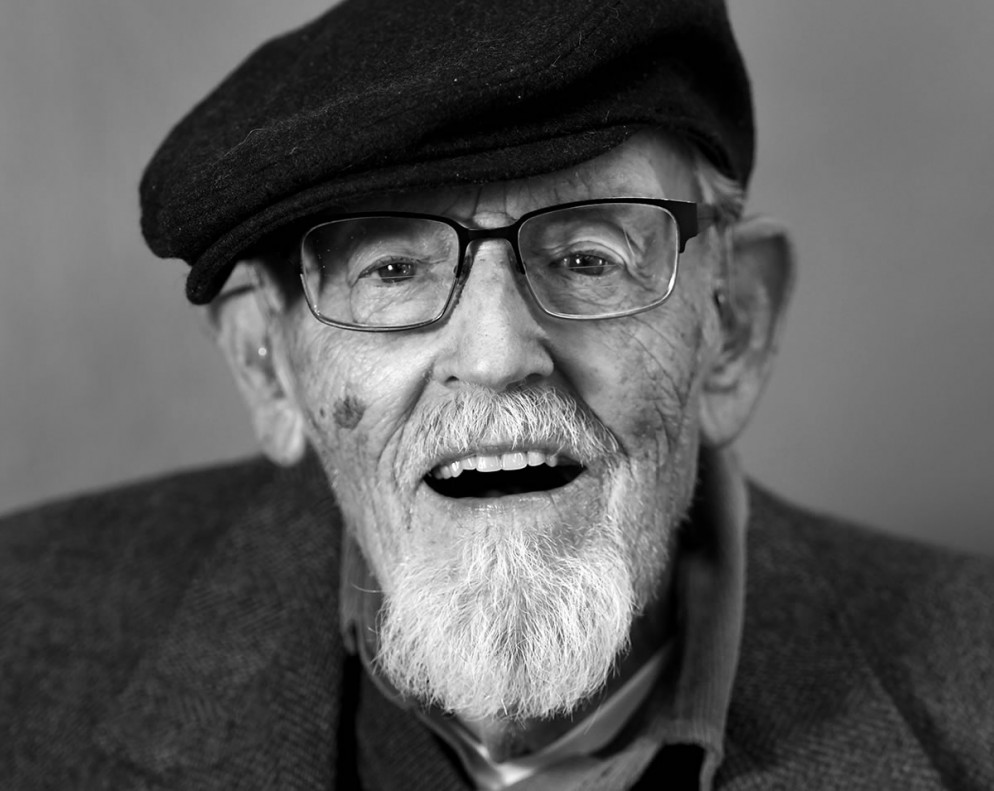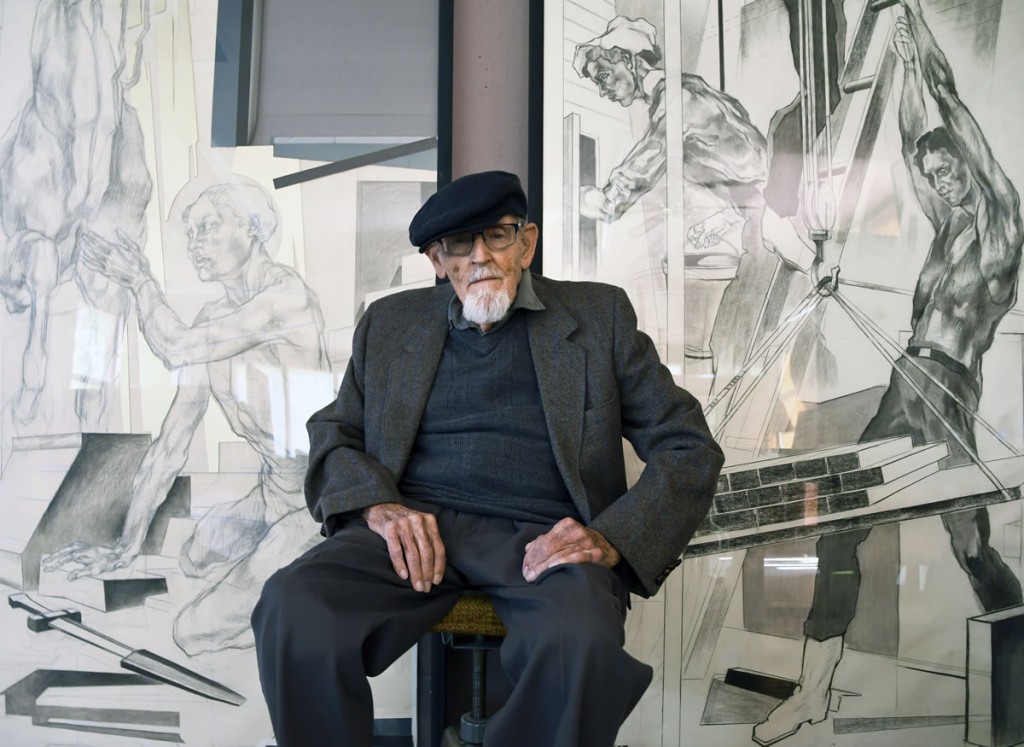At 100 years young, Eric Bransby ’47, M.A. ’49 attracts awe as a muralist and a man
While studying at the Kansas City Art Institute in the late 1930s and early ’40s, Eric Bransby found room and board at a funeral home. He’d set out the chairs and shine the hearses, and wait patiently for new autopsies. “I’d go down in the embalming room,” he remembers, “and sit in the corner and draw from dead bodies.”
It was a professional boon for an aspiring artist. But Bransby leveraged it personally as well, in courting a fellow artist named Mary Ann Hemmie.
“I would borrow the family car to take her for a ride — students didn’t have cars there,” he says. “And I would take her day-old flowers, too.”
Eighty years later, at age 100, Eric Bransby is still painting, which testifies to an inextinguishable passion for his art. But it also speaks to a relentless resourcefulness that usually wins out.
It did with Mary Ann, who accepted those flowers and, before long, his marriage proposal. It did in the art world, too, where Bransby’s ability to see possibility in blank walls has made him one of America’s most renowned mural painters.
Bransby is fascinated by the human form. He traces this back to high school, where a marionette show inspired him and a friend to build their own little theater. With a comic’s timing, he quips, “We were high school kids, and we were playing with dolls.”
His interest intensified when he studied in Kansas City under Thomas Hart Benton, an accomplished muralist and a leader of the Regionalist movement. In 1942, Bransby painted his first mural, a Works Progress Administration project for a local high school.
Upon being drafted into World War II, Bransby was posted at Fort Leavenworth, Kansas. He drew maps and charts, and created visuals for officers’ presentations. But he also talked his way into creating a set of murals on the post’s history. And at night, he painted figures by the dim light of the latrine.
It was 1945 when he, Mary Ann, and their daughter, Fredericka ’65, came to the Colorado Springs Fine Arts Center so Bransby could study under illustrator and artist Boardman Robinson. With the FAC serving as CC’s de facto arts department, it wasn’t long before his transcript — which included old credits from a small Iowa college — came across the desk of CC Director of Fine Arts Carol Truax.
“She said, ‘With this background in the liberal arts, we can give you a B.A. in one year. Moreover, because of six years of professional art training, we can give you an M.A.,’” Bransby remembers. “And I said, ‘Well, as long as they’re handing them out, I might as well take them.’”
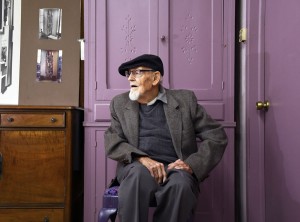 Bransby flourished while at CC. He and Mary Ann bought property south of town and, with the help of her father, constructed a small house. He painted murals at the FAC, the old St. Francis Hospital, Cheyenne Mountain Country Club, and elsewhere. He would still sit in a corner to draw, but not from dead bodies — now his subjects were the graceful students of Hanya Holm, the influential choreographer and longtime CC instructor of dance.
Bransby flourished while at CC. He and Mary Ann bought property south of town and, with the help of her father, constructed a small house. He painted murals at the FAC, the old St. Francis Hospital, Cheyenne Mountain Country Club, and elsewhere. He would still sit in a corner to draw, but not from dead bodies — now his subjects were the graceful students of Hanya Holm, the influential choreographer and longtime CC instructor of dance.
For his master’s thesis, Bransby told Robinson’s successor, Jean Charlot, that he wanted to paint the rotunda of Cossitt Hall — a rounded, 600-square-foot “canvas” that arched as high as 27 feet off the ground, pictured at right. As put by The Tiger student newspaper, “The murals to be painted in secco, include scenes or [of] Indians and whites bartering, the Gold Rush days and the Cattle Industry in this state.” Reflective of Benton’s exaggerated figure-drawing style, and also of Charlot’s insistence that a mural tie into the building architecture, “Settlement of the West” earned Bransby his master’s.
After CC, possibilities abounded. Bransby and his wife even considered going to Frank Lloyd Wright’s Taliesin West school in Arizona. (They met the famous architect there; upon reviewing some of his expressionistic lithographs, Bransby remembers, Wright advised, “Get happy, young man.”)
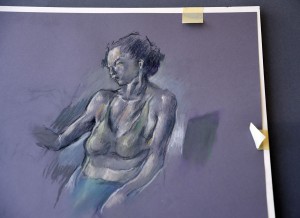 But the ’50s brought major challenges. A tsunami of abstract expressionism endangered Bransby’s beloved figurative art; acknowledging the changing times, he started a Yale University M.F.A. program under Josef Albers. Then money got tight. He took a tenure-track teaching position at the University of Illinois, contingent on him completing his Yale thesis. He did that — creating a fresco-relief mural for a mechanical engineering building at UI — but the damp weather there intensified Fredericka’s asthma, and doctors ordered the family west. So back they came to Colorado Springs.
But the ’50s brought major challenges. A tsunami of abstract expressionism endangered Bransby’s beloved figurative art; acknowledging the changing times, he started a Yale University M.F.A. program under Josef Albers. Then money got tight. He took a tenure-track teaching position at the University of Illinois, contingent on him completing his Yale thesis. He did that — creating a fresco-relief mural for a mechanical engineering building at UI — but the damp weather there intensified Fredericka’s asthma, and doctors ordered the family west. So back they came to Colorado Springs.
Over the next decade, Bransby turned down a fellowship opportunity in Rome and an invitation from Charlot to join his team at the University of Hawaii. Instead, he worked a day job, as an illustrator at the Air Force Academy. Fredericka remembers that although it wasn’t her dad’s dream job, he never phoned it in.
“He feels it is so repugnant to not have the integrity of your passions,” she says.
While at the AFA, Bransby captured the energy of the space race in The History of Navigation, an eight-panel mural series. He took on other murals wherever he could find them. At night, he would sharpen his figure skills by attending life-drawing groups.
So as Fredericka matriculated to CC, Bransby was well equipped to return to the classroom. From the mid-’60s to the mid-’80s, he taught at Western Illinois University and then the University of Missouri, Kansas City. Upon leaving both, he left murals in his wake.
Bransby and his wife returned to Colorado Springs in 1985. In ’86, he repainted Boardman Robinson’s original Fine Arts Center mural for the institution’s 50th anniversary. He returned for the 75th anniversary to paint a new one, aptly titled “Resilience.” In between, he restored the Cossitt Hall rotunda and Shove Chapel’s ceiling mural, and created the 10-foot-by-75-foot “History of the Pikes Peak Region” at the Colorado Springs Pioneers Museum.
Steve Wood ’84 worked closely with Bransby at the Pioneers Museum and at Shove. Asked about Bransby’s style, he references a kind of “semi-cubist approach,” influenced both by Benton and Albers. “But then there is his style as a human — just warm, generous, intelligent, embracing.”
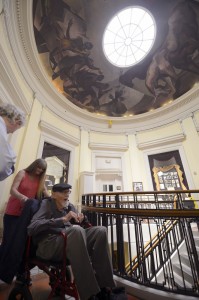 Mural painter Trevor Thomas ’10 had his own apprenticeship with Bransby, during the making of “Resilience.” When Bransby was dealing with Mary Ann’s decline and 2011 death, Thomas took over part of the project. He remembers Bransby leaving him with a directive to paint not for the FAC’s leaders or even its visitors, but for the “janitors, docents, people who have to literally live with these murals.”
Mural painter Trevor Thomas ’10 had his own apprenticeship with Bransby, during the making of “Resilience.” When Bransby was dealing with Mary Ann’s decline and 2011 death, Thomas took over part of the project. He remembers Bransby leaving him with a directive to paint not for the FAC’s leaders or even its visitors, but for the “janitors, docents, people who have to literally live with these murals.”
Says Thomas, “It really helped me know where my own convictions should lie when I set out on an ambitious painting project.”
Today, Bransby continues to teach, holding Saturday drawing sessions on the same property he and Mary Ann bought 70 years ago. On the wall of his studio, alongside a drawing for his 1945 FAC mural, is his 1999 Louis T. Benezet Award from CC, for lifetime achievement.
Recent years have brought other honors: a citation in the Congressional Record, lifetime achievement awards, solo and group exhibitions. In October, he was to have been fêted for his 100th birthday with a premiere showing of “A Last Mural,” Jay Kriss’ documentary about Bransby’s life; when Kriss unexpectedly died, the FAC hosted a smaller gathering instead.
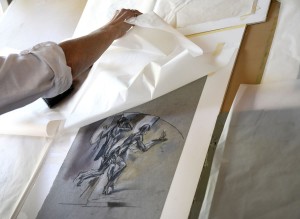 But perhaps the most significant appreciations are, fittingly, of a more practical sort. For one thing, there’s the knowledge that most of his 35-plus murals remain intact and installed today. “It’s so rewarding to find something you painted almost 50 years ago,” Bransby says, “and they still love it.”
But perhaps the most significant appreciations are, fittingly, of a more practical sort. For one thing, there’s the knowledge that most of his 35-plus murals remain intact and installed today. “It’s so rewarding to find something you painted almost 50 years ago,” Bransby says, “and they still love it.”
And then there’s the $30,000 grant he received just this past summer. He has now earned four of these awards from the New York City-based Pollock-Krasner Foundation, and Bransby’s blue eyes dance when he talks about them.
“They go to older artists,” he says, “so they can survive and do their work.”
